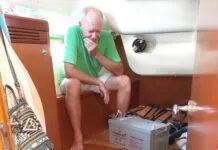When a vigorous debate broke out recently at a local boat show over the ideal orientation of a chartplotter (north up vs. heading up), I held my tongue. Given that some collisions involving commercial ships have been partially blamed on the conflicting orientation of the radar and chartplotter displays, I assumed that there must be an official answer. Turns out, I was only partially right.
First, we need definitions. Per the U.S. Code of Federal Regulations:
• North-up – The line connecting the center with the top of the electronic display is North.
• Heading-up – The line connecting the center with the top of the display is the ship heading.
• Course-up – An intended course (usually the autopilot setting) can be set to the line connecting the center with the top of the display.
As it turns out, the rules for commercial ships allow for either north up or heading up. In fact, the rules require that all electronic aids to navigation, including radar systems, accommodate both orientations seamlessly. There is some preference for heading-up in congested waters with many vessel contacts to be tracked, and north-up in open waters.
THE PLUSES AND MINUSES
Heading-Up. The orientation of all you see and the chart are the same. You can adjust the offset so that more of the chart is in front of you. This works fine when what’s ahead is all that matters, and factors related to wind, waves, and cardinal directions are unimportant.
On the downside, the chart will constantly rotate back and forth if you are playing every wind shift or yawing in a swell. It can be difficult to gauge your progress and orientation when tacking up wind, or estimate if you will lay a mark if the wind is shifting. On older plotters there can be some delay or fuzziness as the chart rotates faster than it can compute. If the compass has a glitch, the system will default to north-up with only a small icon to tell you it changed.
North-Up. Orientation in the big picture is more obvious. Small turns, yawing, and even tacking are not disruptive. Orienting yourself to the icon (which shows your track) is easy when heading north, east, or west, but can challenge some when heading south, perhaps to some extent dependant on how your brain is wired. Determining collision courses is more difficult if your course changes frequently. Cross-checking the plot with a compass bearing is simpler.
Course-Up. A hybrid of the two, this dampens minor spinning that plagues heading-up view. It is useful when you are following breadcrumb route from way point to way point, but this only applies to a boat on autopilot.
If there are radar and GPS displays, there is a strong preference for setting the orientation the same on both. However, unless images from one system overlays the other, there is no requirement that the two systems display the same orientation.
CONCLUSION
Our recommendation is to learn to use both. Training and practice with both views builds a more adaptable and robust navigation ability. For practice, use heading-up in your car on a familiar, low traffic drive. It’s helpful to have information about what is in front of you, and you’ll learn to anticipate the spin of the map when you turn.
Use north-up when sailing open waters, imagining your virtual self in the icon to keep right and left straight
Should you switch views in close quarters? It can make sense in a channel or a river, but even then the north-up view might still be preferable in some scenarios. For me, switching to heading-up in a harbor entrance seems unnecessary, since I will probably switch back to my preferred north-up view to look for a marina or a place to anchor.
If you’re helming on an unfamiliar boat, or taking over a watch, check the settings the first time you glance at the plotters. If it’s not to your liking, first address more pressing elements—local ship traffic, approaching squalls, etc.—before fiddling with settings. If you have a rule for your boat, make sure the crew is aware of it.





































